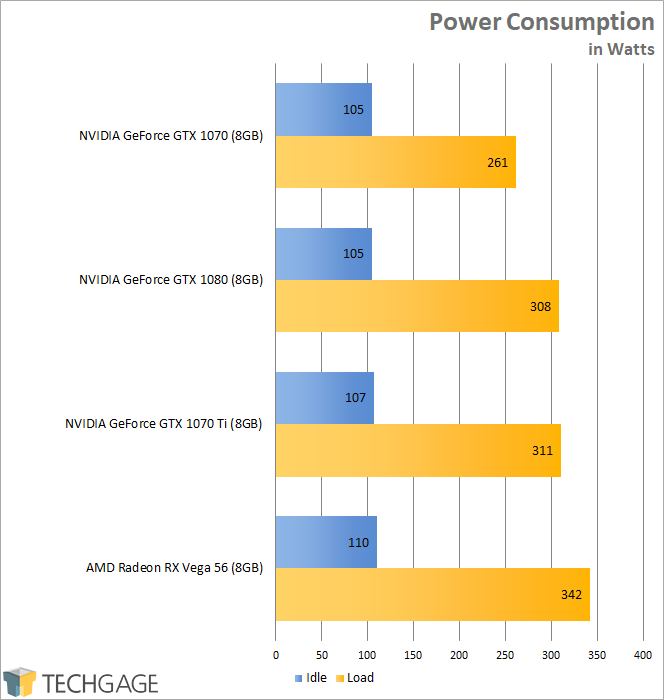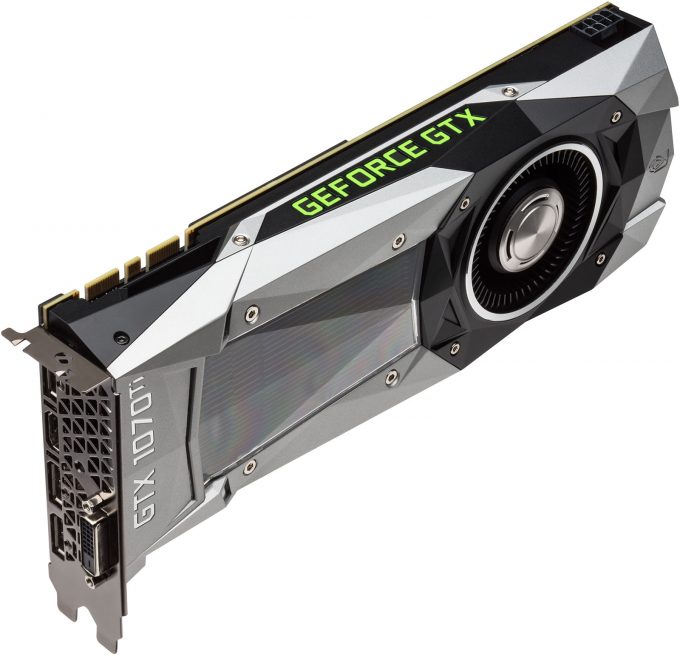- Qualcomm Launches Snapdragon 4 Gen 2 Mobile Platform
- AMD Launches Ryzen PRO 7000 Series Mobile & Desktop Platform
- Intel Launches Sleek Single-Slot Arc Pro A60 Workstation Graphics Card
- NVIDIA Announces Latest Ada Lovelace Additions: GeForce RTX 4060 Ti & RTX 4060
- Maxon Redshift With AMD Radeon GPU Rendering Support Now Available
NVIDIA’s GeForce GTX 1070 Ti vs. Radeon RX Vega 56 & GTX 1070, 1080

Following-up on our look at the synthetic performance of NVIDIA’s GeForce GTX 1070 Ti from a couple of weeks ago, this second diving-in will take care of the performance of real games. In this matchup, four GPUs have entered the ring, where four resolutions await their attempts to deliver high framerates.
Page 4 – Power & Final Thoughts
To test graphics cards for their power consumption at load, I utilize a couple of different tools. On the hardware side, I rely on a Kill-a-Watt power monitor, which the PC plugs into directly. For software, I use GPU-Z to monitor the core temperature, and 3DMark’s Time Spy Extreme 4K test to push the GPU hard.
To test, the area around the (turned off) PC is tested with a temperature gun, with the average temperature recorded as the room temperature. Once that’s established, the PC is turned on and left to sit until the PC is reliably idle (monitored with Task Manager). It’s at this point that the idle wattage is noted, and 3DMark is run. It’s during ‘Graphics Test 1’ that the load wattage is recorded.

Since the moment I tabulated the results for this chart, I realized that I could improve the procedure of capturing the data a lot better, and the result is going to remove 3DMark and replace it with a timedemo that’s not necessarily designed to push the GPU crazy hard the entire run (a 60 second span of 3DMark hardly varied the peak wattage at all). So, bearing that in mind, results may change next time I present them, and those re-tests will be complemented with wattage over time results.
That all aside, it’s interesting that the 1070 Ti drew a couple of more watts than the 1080, at both idle and load. I’m not sure how reliable this data is (hence one of the reasons for improving the test), but it’s clear that the 1070 Ti is aggressively spec’d to take out its leading competitor, the RX Vega 56. But even then, Vega 56 is hard to beat on the power-consumption front (but not for the right reason).
Final Thoughts
The conclusions stemming from all of this testing don’t change at all from the conclusions based on the synthetic testing done a couple of weeks ago. In most cases, the GTX 1070 Ti will outperform the RX Vega 56, although it rarely achieves a truly demanding lead. In certain cases, RX Vega 56 performs better (in particular, with Deus Ex: Mankind Divided).
Days before the GTX 1070 Ti launched, prices of AMD’s RX Vega cards enjoyed sudden drops. I expected those to skyrocket right back up to where they were, but today, the pricing is still reasonable, though not many cards seem to be available at those reasonable prices.
The least-expensive Vega 56 I could find over at Amazon costs $499, while another could be had for $470 at Newegg. Conversely, Amazon has a couple of GTX 1070 Tis for the SRP of $449, and likewise, so does Newegg. With these prices, the GTX 1070 Ti is what I’d recommend; it performs better overall, and costs less (not to mention, it uses less power). It’s a no-brainer, unless you find AMD’s products more alluring for a reason other than perf and power.
I’ve ranted about it before, but GPU pricing today really sucks. It always has, but it sucks more today, especially when mining is involved. The prices I quoted above might not even exist tomorrow, so it’s hard to write a conclusion and feel confident about it for the long-haul. You need to take this information, and then mull over it while you scour for the best possible prices online.
I’d wager that NVIDIA is going to look like the better deal for a little while longer. If compute is important to you, the RX Vega could change your mind, since it is pretty good in certain cases.
If you need more time to think things over, I’d recommend you check out our look at NVIDIA’s Star Wars edition TITAN Xp, while trying not to think about the ridiculously cheap way in which I just promoted it.
Pros
- Offers great performance at 1440p, eats 1080p for brekkie.
- Draws less power than its competition.
- Cards at SRP can be found outside of NVIDIA’s webstore.
- Very overclockable.
Cons
- The FE reviewed does not have the most efficient cooler (but it looks good).
- If you’re spending more than $470, you may as well search for low-priced GTX 1080s.
Support our efforts! With ad revenue at an all-time low for written websites, we're relying more than ever on reader support to help us continue putting so much effort into this type of content. You can support us by becoming a Patron, or by using our Amazon shopping affiliate links listed through our articles. Thanks for your support!






